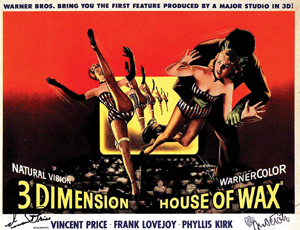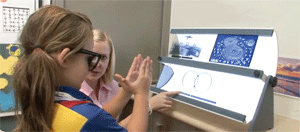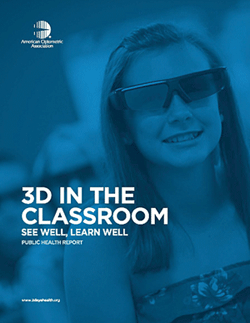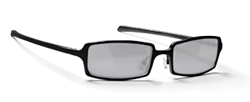 Why is there such an incredible interest in 3-D movies, television, video games and the use of 3-D technology in the classroom? Every time you pick up a newspaper, read a magazine or a blog, surf the Internet or listen to the news, you see stories about simulated 3-D. What’s all the hype about? Is it really hype or something more important to your patients and your practice?
Why is there such an incredible interest in 3-D movies, television, video games and the use of 3-D technology in the classroom? Every time you pick up a newspaper, read a magazine or a blog, surf the Internet or listen to the news, you see stories about simulated 3-D. What’s all the hype about? Is it really hype or something more important to your patients and your practice?
Can we improve the entertainment value of 3-D movies for the movie-going audience? Can we make the extra cost of buying 3-D televisions worthwhile, even for those who now have headaches when they watch 3-D programming? And, what can we do for those children who cannot appreciate the sense of depth in 3-D video games or benefit from the 3-D classroom educational experience? Can we ensure that they do not miss out on the fun and improved academic learning environment?
When it comes to 3-D viewing and the patients we serve, one of the most important questions for the optometrist is: Can we improve the actual user of 3-D content so that the experience can be better appreciated, no matter their age or the type of simulated 3-D content experienced?
The answer is, of course, yes.
3-D Through the Years
3-D viewing and its relation to binocular vision is not a new phenomenon. Thanks to Charles Wheatstone and his stereoscope (in the 1830s) and the soon-to-follow stereopticon invented by Oliver Wendell Holmes (1862), many could enjoy this new form of 3-D entertainment.
In more modern times, the first stereoscopic 3-D television was created in the 1920s by Charles Logie Baird, while the 1950s ushered in the first Golden Age of commercially successful and popular 3-D movies (such as “Bwana Devil” and “House of Wax”).
Thirty years later, another smaller 3-D boom appeared which was initiated by IMAX. Unfortunately, there were many difficulties with this method of producing 3-D viewing because of the large size and unusual dimensions of the theater screen needed.1
During the following elements of the examination, consider these factors if you suspect 3-D vision syndrome.
For information on how to perform these tests, see:
As the history of 3-D technology moved into the present day, “Avatar” (2009) could be noted as bringing the next golden age of 3-D to the masses. In just the past few years, we’ve witnessed a boom in movies, television, video games and other media depicted in 3-D.
Diagnosing 3-D Vision Syndrome
• Schlange D, Maino D. Clinical behavioral objectives: assessment techniques for special populations. In Maino D (ed). Diagnosis and Management of Special Populations. St. Louis, MO: Mosby-Yearbook, Inc., 1995:151-88.
• Scheiman M, Wick B. Clinical Management of Binocular Vision: Heterophoric, Accommodative, and Eye Movement Disorders. Philadelphia: Lippincott; 2008.
• Pang Y, Gabriel H, Frantz KA, Saeed F. A prospective study of different test targets for the near point of convergence. Ophthalmic Physiol Opt. 2010 May;30(3):298-303.
It should be no surprise then that the events that soon followed this current explosion of interest in 3-D should include the American Optometric Association and an industry group called the 3D@Home Consortium signing a memorandum of understanding, which stated their intent to share data and jointly promote vision health utilizing stereoscopic 3-D displays.2 Both the AOA and 3D@Home have joined forces by collaborating on a new venture: 3deyehealth.org.
Creating 3-D
As every optometrist knows, the creation of simulated 3-D content requires the input of one image into the right eye and another similar but laterally displaced image into the other eye. When the brain receives the two images, fusion occurs and a sense of depth is created. When optometric vision therapy is used to treat those with binocular vision dysfunction, this is typically done by having the patient wear anaglyph (red/green or red/blue) glasses, Polaroid glasses, or by synchronizing the timing of the image to be received by each eye in such a way so that only one eye sees an image at any one time. This is also true for most of the 3-D content our patients view commercially.
There are several types of glasses that consumers can use to experience simulated 3-D. They are categorized as passive polarized or active shutter. (There is also a way to create 3-D without the need for glasses, such as with the Nintendo 3-DS or the photographic art of Almont Green, but I’ll limit the discussion to the passive polarized and active shutter glasses.3,4)
Passive polarized glasses are either linearly or circularly polarized. Linear polarized 3-D glasses work with the older stereo projectors, StereoJet prints, and modern projector systems with linear polarizers. If you use linear polarized glasses, you cannot turn or tilt your head without losing the 3-D effect. Circular polarized glasses allow you more leeway in terms of head position and are the glasses most often used in movie theaters.
Active shutter glasses work when voltage is applied to one of the lenses, which makes it turn dark while the other lens remains clear and vice versa. This quick alternation of the image is synched with the screen showing the 3-D content being viewed by each eye at a slight lateral disparity, which creates the 3-D effect.5 Most 3-D movies use various polarizing techniques, while 3-D TVs favor active shutter methodologies.
The most frequently used technologies for 3-D entertainment in theaters are those produced by IMAX 3D, RealD 3D, Dolby 3D and XpanD 3-D. When IMAX first started showing 3-D, it used active shutter glasses, but it now uses linear polarization. RealD 3D uses circularly polarized glasses, which reduces problems when viewers tilt their heads. Dolby 3D, however, uses a special color wheel attached to the projector. This color wheel splits the wavelengths used by the left and the right eyes. The glasses used for Dolby 3D have very accurate color filters (dichroic or interference filters) that send the appropriate wavelengths of light into the eyes of each movie patron. Lastly, XpanD 3-D uses active shutter glasses that are synchronized with the projector using infrared signals.
Diagnosing 3-D Vision Syndrome (3DVS)
Although the technology to produce 3-D viewing is constantly being improved, not everyone is able to experience and enjoy simulated 3-D because of vision problems that cause headaches, nausea, diplopia and other symptoms. This is not only true for children but also for adults.6
According to the American Optometric Association’s 2011 American Eye-Q survey, parents are concerned about the possible detrimental effects of 3-D viewing. Fifty-three percent of respondents with children 18 or younger believe that 3-D, viewing is harmful to a child’s vision.7 However, the AOA and several other organizations note that there is currently no research to support the belief that 3-D viewing is harmful to a child’s vision.
What the primary care optometrist needs to do is improve the patient’s binocular vision skills. This will create a better 3-D viewing audience that can participate in an enhanced and symptom free 3-D experience. The first step to making this happen is to use all the resources available to you to get the word out about how optometry can help make the 3-D viewing experience more enjoyable. This will enable you to reach those patients most in need.
Phases of Optometric Vision Therapy
Phase 1
Monocular: The monocular phase of therapy often includes the following oculomotor, hand-eye and accommodative therapy procedures:
• Hart chart saccades
• Hart chart accommodative rock (
www.youtube.com/watch?v=fX8mqtgdzgs)
• Rotating pegboard
• Computer paddle ball (
www.youtube.com/watch?v=FenLQ3mKpwQ)
• Bunt ball (
www.youtube.com/watch?v=RTy3o8DwON8)
• Plus and minus lens flippers
• Wayne saccadic fixator (
www.youtube.com/watch?v=S21z6hBpFOY)
• Vision coach (
www.youtube.com/watch?v=kbcXr5IxXAM)
Phase 2
Biocular: The biocular therapy phase is often used to break down any suppression present and includes oculomotor, hand-eye, accommodative and anti-suppression therapies:
• Barrel card (
www.youtube.com/watch?v=HtzEHSie-90)
• Split vectogram (
www.youtube.com/watch?v=Tzieb5qDvJA)
Phase 3
Binocular: This binocular phase of therapy often includes the following oculomotor, hand-eye (if still needed), accommodative and vergence therapy procedures:
• LifeSaver cards BI (
www.youtube.com/watch?v=Ui3KTZOdzbo)
• LifeSaver cards BO (
www.youtube.com/watch?v=wcVX684r3xQ)
• Brock string (
www.youtube.com/watch?v=EGlCVTdNqfw)
• Vectograms (
www.youtube.com/watch?v=oiuzE6hc7NI)

Integration/Stabilization: This phase includes combined oculomotor/hand-eye/accommodative/vergence therapy. (This is where you might use plus or minus lens and/or prism flippers with Vectograms, aperture rule and other vergence and/or oculomotor activities.)
• Brock string with flippers (
www.youtube.com/watch?v=5S_fYs-EAI0)
Also note that although randomized clinical trials have shown that in-office optometric therapy is most effective for binocular vision disorders, home computer therapy is helpful for treating these disorders as well. These home therapeutic digital programs include but are not limited to Home Therapy Systems (
www.homevisiontherapy.com), PVT Perceptual Visual Tracking and Amblyopia iNet (
www.visiontherapysolutions.net), and Computer Aided Vision Therapy: Track and Read and Computer Vergences (
www.cavt.net).
In order to assist you in getting the word out about what optometry can do to improve the 3-D viewing experience, the AOA,
3D@Home Consortium and 3deyehealth.org have come together to let the public know about “The 3Ds of 3-D Viewing”:
-
Discomfort: Because 3-D viewing is based on the eyes converging in front of or beyond the screen, viewing 3-D images can potentially create eyestrain and headaches.
- Dizziness: 3-D technology can exaggerate visual motion hypersensitivity (VMH) or vision-induced motion sickness which can cause individuals to feel dizzy or nauseous during or after viewing 3-D content.
- Lack of Depth: A viewer lacking binocular vision simply won’t see 3-D. While this doesn’t pose any problem viewing the screen, it certainly significantly detracts from the enjoyment most experience while viewing 3-D content and makes spending the extra money for the 3-D experience worthless. This can, however, serve as a public health “vision screening” that something is abnormal with the viewer’s vision.
Although not stated directly, the fourth D of 3-D viewing should be: If you do not appreciate 3-D or you experience asthenopia while watching 3-D content, you should immediately make an appointment with your Doctor of Optometry.8
The way to create a better 3-D viewing audience is first to diagnose any binocular vision problems present to determine if your patient has 3-D vision syndrome (see “ Diagnosing 3-D Vision Syndrome.”).9-11 3-D vision syndrome (3DVS) is comprised of a group of symptoms that collectively indicate the presence of a functional vision disorder which adversely affects the enjoyment level of watching 3-D content. 3DVS symptoms include, but are not limited to asthenopia, headaches, blurred vision, eyestrain, diplopia, dizziness/nausea and vision-induced motion sickness after watching a 3-D movie, viewing 3-D television programming, participating in a 3-D classroom educational activity or after playing a 3-D video game.12
While we’ve known for some time that 3-D viewing can cause vision problems to manifest, research is only now beginning to determine which functional or group of functional vision disorders are involved in causing the 3DVS-associated symptoms.13-15 One or more papers suggest that the symptoms produced are caused by:16-18
- Excessive demands placed upon the linkage of accommodation-convergence by viewing fast-moving 3-D images.
- Spatial and temporal inconsistencies created by 3-D artifacts from insufficient depth information.
- Blur.
A more recent study notes that conflicts in motor responses drive visual discomfort and fatigue because, if the visual system does not attempt to make a motor response when a vergence-accommodation conflict is present, no discomfort occurs.19 This is an interesting finding because at least one other paper suggested the primary cause of symptoms in at least one binocular vision disorder (convergence insufficiency) is the associated dysfunction noted in accommodation.20
Treating 3DVS
No standard, successful treatment has yet been established for 3DVS. However, at last year’s American Academy of Optometry meeting, we presented a single subject design study that clearly demonstrated how a patient with 3DVS can be treated successfully with optometric vision therapy (OVT).21 (See “
Phases of Optometric Vision Therapy.”)
The poster described a 27-year-old white female who began to experience severe symptoms after viewing a 3-D movie for 15 to 20 minutes. These symptoms included blurred vision, diplopia, eyestrain, visual tracking problems, headache, nausea and vision-induced motion sickness. A comprehensive examination noted reduced random dot stereopsis, no positive/negative fusional ranges (immediate diplopia), and high exophoria at near. Also, she reported diplopia while accessing accommodative facility. The initial findings included a variable Monocular Estimation Method (MEM dynamic retinoscopy), pain upon near point of convergence testing, and reduced positive relative accommodation and accommodative amplitudes.
We diagnosed this patient with convergence insufficiency, accommodative infacility/instability/insufficiency, and diplopia. She was prescribed in-office OVT and home VT. After the first six therapy sessions, all symptoms were either improved or eliminated. Upon completing a program of out-of-office (eight sessions) and home-based optometric vision therapy, all findings normalized and all symptoms relieved.
The patient was so pleased with therapy outcomes that several weeks post therapy, while she was in the middle of watching a 3-D movie, she used her cell phone to text me about how much she enjoyed watching it without experiencing any pain or discomfort!
Make 3-D Pop Up in Your Practice
Here’s how:
 With the unending attention centered on 3-D movies, 3-D televisions, 3-D video games, and 3-D in the classroom, your office should take advantage of the educational and marketing possibilities. Your existing and potential patients are aware of many of the issues surrounding simulated 3-D viewing, but have you made them knowledgeable about the services you offer so that they can enjoy the digital dazzle associated with this new technology?
With the unending attention centered on 3-D movies, 3-D televisions, 3-D video games, and 3-D in the classroom, your office should take advantage of the educational and marketing possibilities. Your existing and potential patients are aware of many of the issues surrounding simulated 3-D viewing, but have you made them knowledgeable about the services you offer so that they can enjoy the digital dazzle associated with this new technology?
-
Offer a seminar about 3-D in your office. Use this article or other resources to help tell your patients how simulated 3-D is produced and why some individuals have problems associated with 3-D Vision Syndrome. Use prism to make individuals in the audience diplopic. Use the Brock string to see how many in the audience have binocular vision dysfunctions—I did this at the 2011 Consumer Electronics Show and the response was astounding! [Watch the video at http://mainosmemos.blogspot.com/2011/04/dr-dominick-maino-at-consumer.html.]
-
Set up a Google Alert search on 3-D. Find all the media topics and post links on your office webpage. Also post these links with commentary on your blog, Facebook page and LinkedIn page.
-
Let your patients know you can diagnose and treat or refer for treatment those with 3-D Vision Syndrome.
-
Obtain copies of “3-D in the Classroom See Well, Learn Well” from the AOA and send it to the schools in your area with compliments from your office. Put links on your office webpage and social media sites to this document and send email to all the teachers, principals, school administrators and parents you know. (Go to 3deyehealth.org for more information.)
-
Display 3-D art, movie posters and photographs in your office. (See the astounding work of Almont Green at almontgreen.com. He creates great 3-D photographic art. There are also 3-D movie posters available from www.allposters.com/-st/3-D-Movie-Posters_c118624_.htm, while vintage 3-D movie posters can be found at www.3dstereo.com/viewmaster/3dposters.html.)
-
Offer 3-D glasses with your patients’ prescription in them. Samsung displayed a number of active shutter prescription ready glasses at the 2011 Consumer Electronics Show. Other manufacturers offer prescription-ready glasses as well (such as those by Marchon, which now offers Marchon 3-D glasses and even 3-D clip-ons, www.marchon.com/M3D, and Gunnar Optiks, www.gunnars.com/shop/Premium-3D-Eyewear). Remember that 3-D TV glasses only work with specified televisions. Make sure you mention this to your patients so they know that a new pair of glasses may be necessary if they buy a different TV.
-
Make your own 3-D art and photographs and display them in your office ( www.3d-image.net).
Dr. Maino is a Fellow of the College of Optometrists in Vision Development and American Academy of Optometry, as well as a Professor of Pediatrics/Binocular Vision at the Illinois Eye Institute/Illinois College of Optometry and is in private practice in Harwood Heights, Il.
1. Schubin M. Eyes wide open: 3-D tipping points loom. PriceWaterhouseCoopers. Available at:
www.pwc.com/en_GX/gx/entertainment-media/pdf/Eye_Wide_Open_3D_Tipping_Points.pdf. Accessed July 2011.
2. The American Optometric Association and 3-D@Home Consortium Sign Memorandum of Understanding. Available at:
www.3deyehealth.org/AOA-3-DatHome-MOU-announcement.pdf. Accessed July 2011.
3. Nintendo 3-DS product information. Available at:
www.nintendo.com/3ds/hardware. Accessed July 2011.
4. Almont Green.
http://almontgreen.com. Accessed July 2011.
5. Younkin AC, Anderson GJ, Doherty RA, Corriveau PJ. Toward a comprehensive assessment of user experience with 3D. Proceedings of the Fifth International Workshop on Video Processing and Quality Metrics for Consumer Electronics VPQM-2010. Available at:
http://enpub.fulton.asu.edu/resp/vpqm/vpqm10/Proceedings_VPQM2010/vpqm_p35.pdf. Accessed July 2011.
6. Maino D, Chase C. Asthenopia: Technology Induced Visual Impairment. Rev Optom. 2011;June Suppl Part 2: 28-35. Available at:
www.revoptom.com/cmsdocuments/2011/6/0611_b+l_13thedition.pdf. Accessed July 2011.
7. American Optometric Association website. New Survey Data Reveals Parents’ Concerns About Eye and Vision Health as More Classrooms Go High-Tech. August 2, 2011. Available at:
www.aoa.org/x18810.xml. Accessed August 2011.
8. 3-D Vision and Eye Health website. Available at:
www.3deyehealth.org. Accessed July 2011.
9. Maino D. Identify Binocular Vision Disorders. Optometric Management. 2009 Dec;(12). Available at:
www.optometric.com/article.aspx?article=103756. Accessed July 2011.
10. Maino D. The binocular vision dysfunction pandemic. Optom Vis Dev. 2010;41(1):6-13.
11. Scheiman M, Wick B. Clinical Management of Binocular Vision: Heterophoric, Accommodative and Eye Movement Disorders. 3rd ed. Philadelphia: Lippincott; 2008.
12. Maino D. Mainos’s Memos. What is 3-D Vision Syndrome? Available at:
mainosmemos.blogspot.com/2010/11/3d-vision-syndrome_12.html. Accessed July 2011.
13. Tsukuda S, Murai Y. A case report of manifest esotropia after viewing anaglyph stereoscopic movie. Japanese Orthoptic Journal. 1988;18:69-72.
14. Lambooija,M, Fortuina MF, IJsselsteijn WA, Heynderickx I. Visual discomfort associated with 3D displays. Proceedings of the Fifth International Workshop on Video Processing and Quality Metrics for Consumer Electronics VPQM-2010. Available at:
http://enpub.fulton.asu.edu/resp/vpqm/vpqm10/Proceedings_VPQM2010/vpqm_p44.pdf. Accessed July 2011.
15. Iwasaki S, Kubota T, Tawara A. The tolerance range of binocular disparity on a 3D display based on the physiological characteristics of ocular accommodation. Displays. 2009 Jan;30(1):44-48.
16. Yano S, Ide S, Mitsuhashi T , Thwaites H. A study of visual fatigue and visual comfort for 3-D HDTV/HDTV images. Displays. 2002; 23(4):191-201.
17. Hoffman DM, Girshick AR, Akeley K, Banks MS. Vergence–accommodation conflicts hinder visual performance and cause visual fatigue. J Vision. 2008 Mar 28;8(3):33.1-30.
18. Lambooij M, Fortuin M, IJsselsteijn WA, Heyndrickx I. Measuring visual discomfort associated with 3-D displays. Proceedings of SPIE-IS&T Electronic Imaging. 2009. Available at:
http://repository.tudelft.nl/view/ir/uuid:ff0f527c-2342-4aea-ae73-e97ec0d6f906. Accessed August 2011.
19. Shibata T, Kim J, Hoffman DM, Banks MS. The zone of comfort: Predicting visual discomfort with stereo displays. J Vision. 2011 July 21;11(8):11;1-29.
20. Marran LF, De Land PN, Nguyen AL. Accommodative insufficiency is the primary source of symptoms in children diagnosed with convergence insufficiency. Optom Vis Sci. 2006 May;83(5):281-9.
21. Maino D. The 3 D Vision Syndrome: A Case Report [abstract]. American Academy of Optometry Annual Meeting Nov 2010, San Francisco, CA. Available at:
www.slideshare.net/DMAINO/3d-vision-syndrome. Accessed July 2011.

